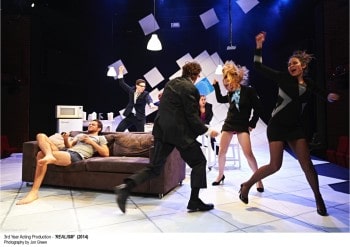Realism – WAAPA
Anthony Neilson’s Realism, first staged as part of the 2006 Edinburgh International Festival, is a surreal tour de force.

Realism muses on mundanity, the weirdness of modern life, and the emotional baggage (“the accumulation of losses”) we all eventually realize we’re lumped with when we wake up from our frivolous party years with the biggest hangover of them all: the need to take responsibility for our actions and live with the sometimes sad consequences of our choices. Realism’s 80 minutes plays in the vein of fantasy-comedy films like Spike Jonze’s Being John Malkovich, or Irvine Welsh’s Filth; in both works the audience enters a portal into the mind of man.
Speaking of Filth, you can’t help but wonder; during some of Liam’s more abject fantasties (ie a spank-happy threesome on a toilet between himself and his two exes), if Scottish playwright Nielson was influenced by fellow Scotsman Welsh’s humour-rich, bold dissections of (mostly) adult males and their secret embarrassments – there’s an uncanny similarity between the unfurling of the subconscious of Filth’s Bruce Robertson and that of Realism’s beleaguered protagonist; although Welsh tends more towards the extreme and Realism’s social commentary, whilst engaging with isn’t nearly as damning.
Nevertheless, ‘sex sells’, and this was nowhere more evident than in the play’s marketing: there were qualms using sensationalism and suggestions of risqué content to sell seats. It worked – the night we attended – despite being a wild and wooly-weathered, early weeknight (that can often spell the death of patron numbers) there was nearly a full house; and other evenings in the season have followed suite. After seeing the play, however, there is a sense that perhaps the cast needed to balance their efforts across the play’s duration; there was a sense of reliance on the titillating aspects of the play to satisfy its audience, at the mercy of the script’s remaining content: you had to wonder if the distracting ‘sexy bits’ were completely taken out of the picture; was there enough remaining theatrical substance to hold up this production of Realism?
In the original work, the play’s lead is “a middle-aged loser”, but – at the playwright’s encouragement – companies are encouraged to adapt the play’s context and character names to the real context and actors’ own names. So for WAAPA’s Third Year performance of Realism, the lead is a twenty-something year old, slobby bro in a sharehouse, that takes actor Liam’s own name. Likewise, the company do away with the Scots accents for local language, replete with Australian slang. The play is set during a day where Liam does, in his own words, “fuck all”, content to mope in his underwear in the wake of a failed relationship. What is a day of nothing becomes a day of exploring the entire human spectrum of emotion via a kitchen-sink drama of minstrel shows and male sexual fantasties, in which Liam’s past and present, personified by members of the past, slide out from daytime television shows, from between the sheets of his bed, crawl in through through his kitchen window, and pop out of various household appliances. Liam’s pet cat surrealistically appears as a giant feline monster (which deadly serious is something that actually happened to me last time I went on an acid trip, so I was really feeling Liam talking to his cat in that moment!).
Sound design was slightly heavy-handed; with loud classic pieces overly relied on for emotional impact, to the inverse, gentle musical interludes provided by actors Harriet Davies (playing Liam’s former girlfriend) and Alexis Lane (playing Liam’s mother) were really touching (a huge achievement, given the general dread most audiences have of those ‘I feel a song coming on’ moments). Lane’s performance throughout was mature and knowing; her monologue to Liam musing on love was one of the play’s most tender and believable moments. Kirsty Marillier, playing Liam’s recent ex, confidently took on the more adventurous requirements of her role and was well-voiced throughout, Harriet Davies’ turn was brief but solid, though unnecessarily melodramatic at points.
As for the dudes – Alexander Frank has a gentle comic expression mastered, and was completely loveable and real as Alfie, and Adam Sollis and Ben Kindon accomplished chameleons of the stage, not flagging for a moment despite both acting in several roles. Being onstage for the entire duration of a production is a huge feat for any actor in their career, and Liam Macguire can now proudly put that baby under his belt, displaying incredible energy and carrying the play’s cast, doing a particularly nice job of conveying his character’s morphing sense of blitheness, self-pity, apathy, and regret.
Sarah Duyvestyn’s set was a standout; a beautifully realised design that bent the tiled floor of a rundown sharehouse halfway up the walls in a surreal, artistic warp, with a film screen through a stripped off tile acting as a window, playing daytime and night time sky scenes. Elsewhere in the tile wall laid a flap through which actors entered and exited, surprising the unwary. Another notable set piece was a piece of exposed black rigging that lowered to become a shower head; pivotal (along with some blue spotlighting) in conveying a despairing mood in a sophisticated theatre moment when Liam sits beneath the shower, wet, naked and vulnerable.
Self-aware moments where the play’s stage managers introduce themselves to cast members and explain their role offer a light nod towards the fact that this is theatre, and not real at all. Being reminded that theatre is a medium for experimentalism and creativity is important, given that scenes in Nielson’s script don’t add up to advance any kind of traditional narrative (i.e. a meaningless, dawdling scene in which Liam, egged on by his roommate, is encouraged to dispatch a cold caller who later turns out to be disabled). Thus it’s perhaps preferable when viewing Realism for one to put aside that internal compulsion to locate for oneself a cohesive narrative form, and instead view each scene as stand-alone tableaus, scattered-through-time frozen subconscious moments thawing themselves out of Liam’s head for the duration of each scene. This works as a fun romp initially, as the constantly metamorphosing cast all throw themselves in at each turn for magnificent (if baffling) enactments of components of Liam’s personal world and their greater social context.
However, these movement-frenzied, confetti-laden, sexed-up bursts don’t proffer the aptitude for the audience to emotionally connect to events thrust at us during the play’s later, sombre stages. Case in point being the inexplicable death of the lead’s mother, and the lead’s own death fantasy, in adjacent scenes. Not exactly sure how Nielson expected his audience to be affected by the loss of two characters who’d barely had time to endear themselves to us with any sense of truth amidst the on-stage dream/nightmare madness.
Therein lies the crux defining this performance of Realism – one leaves their night at the theatre entertained and impressed in requisite doses, but with the overall sense that perhaps Nielson’s work is a slightly too ambitious undertaking, a script whose successful stage execution presents a tall order for even the most accomplished industry professionals (with the added requirement of comic, on top of dramatic, aptitude), let alone a young, student cast. Yet all players involved clearly demonstrated total enthusiasm and commitment to Nielson’s script: attributes that will serve these third years well as undergo their own versions of the character Liam’s maturation, as they exit the head of WAAPA and go out through the set flap and into a new industry reality.

